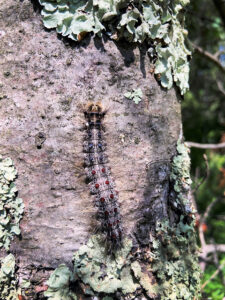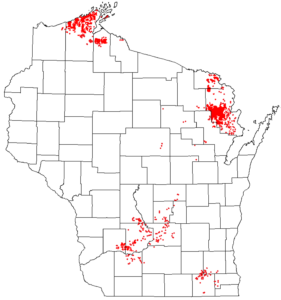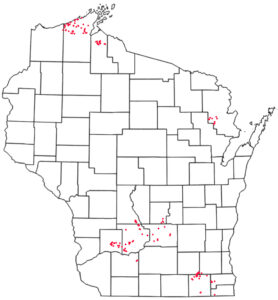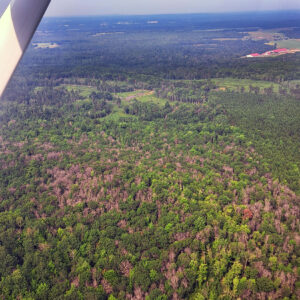
Mature spongy moth larva on a tree at Potawatomi State Park in Door County, July 2025. / Photo Credit: Wisconsin DNR
By Bill McNee, DNR Forest Health Specialist, Oshkosh
Bill.McNee@wisconsin.gov
Wisconsin’s recent period of high spongy moth populations (an “outbreak”) came to an end in 2025, as the remaining known hotspots were aerially sprayed or naturally collapsed. Only a handful of large larvae were observed or reported by property owners.
Spongy moth populations are likely to be low across the state for at least the next few years. However, it is possible that some sites may experience a population increase before then, if local weather conditions are favorable for the insect.
No Defoliation Observed in 2025

Map 1: A map showing all spongy moth defoliation that was mapped during the 2022-24 outbreak. Small areas are enhanced to show defoliation. Scattered mortality representing less than 10% of a polygon is not shown. / Map Credit: Wisconsin DNR
No observable spongy moth defoliation was mapped during Wisconsin Department of Natural Resources aerial surveys this summer. This represented a significant shift from the 375,000 acres of defoliation mapped in 2023 and the 334,000 acres mapped in 2024 (Map 1). The outbreak largely collapsed in 2024 after the heavy defoliation had occurred, primarily due to the caterpillar-killing NPV virus and Entomophaga fungus. Scattered and light defoliation was expected in 2025, but none was seen.
Post-Outbreak Mortality Surveys Completed

Mapped spongy moth defoliation-related tree mortality in 2025. Red areas are enhanced to show small patches of mortality. / Map Credit: Wisconsin DNR
Mapped acreage of mortality in oak and aspen grew dramatically in 2025 (Map 2), primarily due to an increase in tree mortality in South Central, Northeast and Northwest Wisconsin. This mortality was typically seen in areas that were heavily defoliated during the 2022-24 spongy moth outbreak, with several droughty summers simultaneously stressing the trees. During an outbreak, tree mortality can be difficult to spot in a stand where defoliation is also present. Much of the mortality mapped in southeast Wisconsin this summer was present in 2024, with additional mortality mapped in 2025 (Map 2).
Reported oak mortality was seen over 14,324 acres. Counties with the most observed oak mortality in 2025 were: Sauk (2,852 acres), Jefferson (2,433 acres), Marinette (1,935 acres), Juneau (1,848 acres) and Bayfield (1,799 acres). Reported aspen mortality was seen over 6,197 acres in Bayfield (3,668 acres) and Ashland counties (2,529 acres).

Heavy oak mortality from previous spongy moth defoliation in Bayfield County, August 2025. / Photo Credit: Wisconsin DNR
(Note: Acres reported denote areas where mortality comprised more than 10 percent of the area mapped; less than 10 percent mortality was considered scattered mortality and is not reflected on the map. Additional tree mortality is likely present in areas that were not surveyed.)
Aspen has been reported to have low mortality rates in the absence of other stresses, and the recent droughty summers may have contributed to the large amount of observed aspen mortality.
Additional tree mortality is expected in both Southern and Northern Wisconsin over the next few years. Property owners with oak and other species preferred by spongy moth caterpillars should annually monitor their trees for signs of decline and mortality and contact an arborist or forester if necessary. In particular, weakened oaks often linger for 1-3 years before finally dying. Weakened oaks are commonly infested by Armillaria root disease and twolined chestnut borer. The DNR’s August edition of Forest Health News had an article summarizing the management of impacted stands. Watering yard trees during dry periods can help to reduce tree stress and increase the likelihood of survival.
Conduct Egg Mass Surveys to Predict Next Year’s Populations

Three spongy moth egg masses on a branch in Walworth County in 2021. / Photo Credit: Wisconsin DNR
Late fall is a good time to look for and dispose of spongy moth egg masses produced during the summer by adult moths. Management options include scraping egg masses into soapy water or applying an egg mass oil to suffocate the eggs. An egg mass survey can be conducted to help property owners and communities predict the level of defoliation in 2026, and to determine if active management is needed.
A “Protect Your Trees From Spongy Moth” video is available online to assist property owners in conducting predictive egg mass surveys.
Sites where heavy caterpillar mortality was seen over the past two summers are unlikely to have high numbers of egg masses. Spongy moth is considered generally established across the eastern two-thirds of Wisconsin in the quarantined counties (Map 3), but small numbers of egg masses may also be found at sites in the western counties that are not quarantined.
Spongy moth egg masses are tan-colored lumps about the size of a nickel or quarter and are found on trees, buildings and other outdoor objects. They may also be found in protected places such as firewood piles and birdhouses. Each newly produced egg mass contains hundreds of eggs that will hatch in the spring. Newly produced egg masses will feel firm and appear darker in color than older egg masses, which appear faded, feel spongy and do not contain viable eggs.
Additional Recommendations

A pocket of oak mortality on the Kettle Moraine State Forest in Waukesha County, September 2025. / Photo Credit: Wisconsin DNR
Property owners are encouraged to examine their trees and take action if needed. Specifically:
-
- Visit the online Spongy Moth Resource Centerfor management information relevant to both forest and ornamental trees. Physical controls and insecticide application to individual trees may be a suitable management strategy while populations are low.
- Consult a forester or arborist for additional management recommendations. The DNR maintains an online forester directory. When seeking an arborist for advice about ornamental trees, check both of these directories: Wisconsin Arborist Associationand International Society of Arboriculture.
- An aerial spray guide is available online for landowners or groups interested in organizing an aerial spray to protect high-value trees. Planning for an aerial spray in the spring of 2026 should begin this fall. In recent years, for-hire applicators have used airplanes, helicopters and drones to apply insecticide from the air. The State of Wisconsin does not offer a state-sponsored or cost-share program for treating private property to prevent defoliation by spongy moth.

A map of Wisconsin counties quarantined for spongy moth as of October 2025. / Map Credit: Wisconsin DNR
